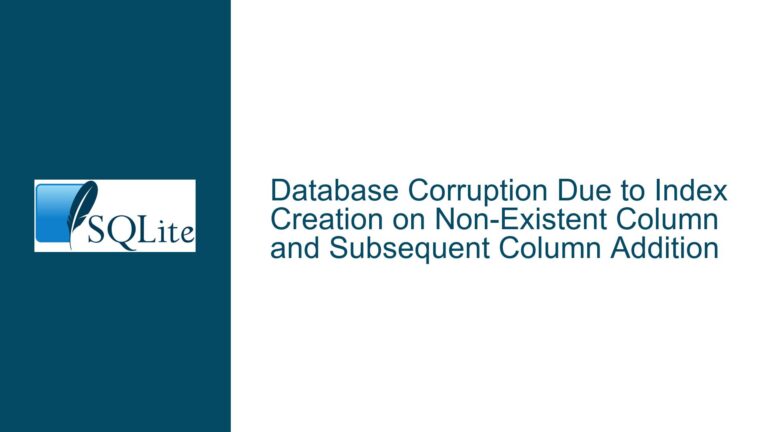the Scope and Limitations of Query Parameters in SQLite
Issue Overview: Query Parameters in SQLite and Their Usage in DDL, DML, and DQL
Query parameters (QPs) in SQLite are placeholders in SQL statements that allow for the dynamic insertion of values at runtime. They are primarily used to sanitize user input and, in some cases, improve performance by reusing prepared statements. However, the scope of where and how query parameters can be used is a common source of confusion, particularly when it comes to their application in Data Definition Language (DDL) statements like CREATE TABLE.
The core issue revolves around whether query parameters can be used in DDL statements, specifically in the DEFAULT clause of a CREATE TABLE statement. For example, can a query parameter be used to define a default value for a column, as in the following statement?
CREATE TABLE test (name TEXT DEFAULT ?);
The confusion arises from the fact that SQLite’s documentation, particularly the syntax diagrams, suggests that query parameters can be used in expressions (expr) within DDL statements. However, the actual implementation and the text of the documentation indicate that query parameters are not allowed in certain contexts, such as the DEFAULT clause, because they are not considered constant expressions.
This discrepancy between the syntax diagrams and the textual documentation has led to misunderstandings, especially among users who rely on higher-level bindings (e.g., PDO in PHP) and may not be familiar with the underlying C API or the intricacies of SQLite’s implementation.
Possible Causes: Why Query Parameters Are Restricted in Certain Contexts
The restriction on using query parameters in certain parts of DDL statements, such as the DEFAULT clause, stems from several fundamental aspects of SQLite’s design and the nature of query parameters themselves.
Query Parameters Are Runtime Entities: Query parameters are bound to values at runtime, typically during the execution of a prepared statement. This means that their values are not known at the time the SQL statement is parsed and prepared. In contrast, the
DEFAULTclause in aCREATE TABLEstatement requires a constant value—a value that is known and fixed at the time the table is created. Since query parameters are not constant, they cannot be used in this context.SQLite’s Schema Storage Mechanism: Unlike some other databases, SQLite stores the schema of a database as raw SQL text. This means that the exact SQL statement used to create a table is stored and can be retrieved later. If query parameters were allowed in the
DEFAULTclause, the schema would need to store the parameter placeholder (?), which would not make sense when the schema is later queried or used to recreate the table. This design choice makes it impossible to support bound parameters inCREATE TABLEstatements.Separation of Program Logic and Data: SQLite enforces a clear separation between program logic (the SQL statements) and data (the values bound to query parameters). Allowing query parameters in DDL statements would blur this separation, as it would allow dynamic values to influence the structure of the database itself. This could lead to security vulnerabilities and other issues, as the schema should be static and not influenced by runtime data.
Consistency with SQL Standards: While SQLite is known for its flexibility and ease of use, it generally adheres to the principles of the SQL standard. The standard does not allow for dynamic values (such as query parameters) to be used in places where constants are required, such as in the
DEFAULTclause of aCREATE TABLEstatement. SQLite’s restriction on query parameters in these contexts is consistent with this principle.
Troubleshooting Steps, Solutions & Fixes: Clarifying and Resolving Query Parameter Misuse
Given the confusion surrounding the use of query parameters in SQLite, particularly in DDL statements, it is important to provide clear guidance on how to properly use query parameters and how to work around their limitations.
1. Understanding Where Query Parameters Can Be Used
Query parameters are intended to be used in Data Query Language (DQL) and Data Manipulation Language (DML) statements, where they can replace literal values. For example, they are commonly used in SELECT, INSERT, UPDATE, and DELETE statements to dynamically insert values at runtime. Here are some examples of valid uses of query parameters:
-- DQL: Using a query parameter in a SELECT statement
SELECT * FROM users WHERE id = ?;
-- DML: Using a query parameter in an INSERT statement
INSERT INTO users (name, age) VALUES (?, ?);
-- DML: Using a query parameter in an UPDATE statement
UPDATE users SET age = ? WHERE id = ?;
-- DML: Using a query parameter in a DELETE statement
DELETE FROM users WHERE id = ?;
In these examples, the query parameters (?) are placeholders for values that will be bound at runtime. This is the primary and intended use of query parameters in SQLite.
2. Avoiding Query Parameters in DDL Statements
As discussed earlier, query parameters should not be used in DDL statements, such as CREATE TABLE, where constant values are required. Instead, you should use literal values or constant expressions in these contexts. For example, if you need to define a default value for a column, you should use a literal value directly in the CREATE TABLE statement:
-- Correct: Using a literal value in the DEFAULT clause
CREATE TABLE test (name TEXT DEFAULT 'unknown');
-- Incorrect: Attempting to use a query parameter in the DEFAULT clause
CREATE TABLE test (name TEXT DEFAULT ?); -- This will fail
If you need to dynamically create tables with different default values, you should construct the SQL statement as a string in your application code and execute it directly, rather than using query parameters. For example, in Python:
default_value = "unknown"
sql = f"CREATE TABLE test (name TEXT DEFAULT '{default_value}')"
cursor.execute(sql)
3. Handling Dynamic Schema Changes
In some cases, you may need to dynamically alter the schema of a database based on runtime data. While query parameters cannot be used for this purpose, you can achieve similar results by constructing the necessary SQL statements dynamically in your application code. For example, if you need to create a table with a column whose default value is determined at runtime, you can build the CREATE TABLE statement as a string and execute it:
# Example in Python
default_value = get_default_value_from_user() # Get the default value at runtime
sql = f"CREATE TABLE test (name TEXT DEFAULT '{default_value}')"
cursor.execute(sql)
This approach allows you to dynamically influence the schema while still adhering to SQLite’s requirement that the DEFAULT clause contain a constant value.
4. Clarifying Documentation and Syntax Diagrams
To prevent future confusion, it is important to clarify the documentation and syntax diagrams to explicitly state where query parameters can and cannot be used. Specifically, the documentation should:
- Clearly state that query parameters can only be used in DQL and DML statements, where they replace literal values.
- Explicitly prohibit the use of query parameters in DDL statements, particularly in contexts where constant values are required (e.g., the
DEFAULTclause). - Provide examples of valid and invalid uses of query parameters to illustrate these points.
Additionally, the syntax diagrams should be updated to reflect these restrictions, either by adding annotations or by modifying the diagrams to exclude query parameters from contexts where they are not allowed.
5. Educating Users on the Separation of Program Logic and Data
Finally, it is important to educate users on the importance of separating program logic (SQL statements) from data (values bound to query parameters). This separation is a fundamental principle of database design and helps prevent security vulnerabilities, such as SQL injection attacks. Users should be encouraged to:
- Use query parameters only for values that will be bound at runtime.
- Avoid using query parameters in contexts where they could influence the structure of the database (e.g., table names, column names, default values).
- Construct dynamic SQL statements carefully, ensuring that any user input is properly sanitized and validated before being incorporated into SQL statements.
By following these guidelines, users can avoid common pitfalls and ensure that their use of SQLite is both secure and efficient.
Conclusion
The use of query parameters in SQLite is a powerful feature that can help improve the security and performance of database operations. However, it is important to understand the scope and limitations of query parameters, particularly when it comes to their use in DDL statements. By adhering to the principles outlined in this guide, users can avoid common misunderstandings and ensure that their use of SQLite is both effective and secure.






